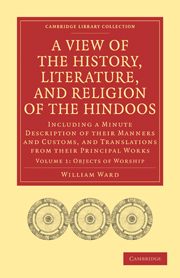 A View of the History, Literature, and Religion of the Hindoos
A View of the History, Literature, and Religion of the Hindoos Book contents
- Frontmatter
- Contents
- INTRODUCTORY REMARKS
- CHAP. I OF GOD
- CHAP. II OF THE GODS
- CHAP. III OF THE GODDESSES
- CHAP. IV INFERIOR CELESTIAL BEINGS OBJECTS OF WORSHIP
- CHAP. V OF THE TERRESTRIAL GODS
- CHAP. VI TERRESTRIAL GODDESSES
- CHAP. VII DEITIES WORSHIPPED BY THE LOWER ORDERS ONLY
- CHAP. VIII WORSHIP OF BEINGS IN STRANGE SHAPES
- CHAP. IX WORSHIP OF HUMAN BEINGS
- CHAP. X WORSHIP OF BEASTS
- CHAP. XI THE WORSHIP OF BIRDS
- CHAP. XII THE WORSHIP OF TREES
- CHAP. XIII THE WORSHIP OF RIVERS
- CHAP. XIV THE WORSHIP OF FISH
- CHAP. XV THE WORSHIP OF BOOKS
- CHAP. XVI THE WORSHIP OF STONES
- CHAP. XVII A LOG OF WOOD WORSHIPPED
CHAP. XVI - THE WORSHIP OF STONES
Published online by Cambridge University Press: 05 October 2010
- Frontmatter
- Contents
- INTRODUCTORY REMARKS
- CHAP. I OF GOD
- CHAP. II OF THE GODS
- CHAP. III OF THE GODDESSES
- CHAP. IV INFERIOR CELESTIAL BEINGS OBJECTS OF WORSHIP
- CHAP. V OF THE TERRESTRIAL GODS
- CHAP. VI TERRESTRIAL GODDESSES
- CHAP. VII DEITIES WORSHIPPED BY THE LOWER ORDERS ONLY
- CHAP. VIII WORSHIP OF BEINGS IN STRANGE SHAPES
- CHAP. IX WORSHIP OF HUMAN BEINGS
- CHAP. X WORSHIP OF BEASTS
- CHAP. XI THE WORSHIP OF BIRDS
- CHAP. XII THE WORSHIP OF TREES
- CHAP. XIII THE WORSHIP OF RIVERS
- CHAP. XIV THE WORSHIP OF FISH
- CHAP. XV THE WORSHIP OF BOOKS
- CHAP. XVI THE WORSHIP OF STONES
- CHAP. XVII A LOG OF WOOD WORSHIPPED
Summary
The Shalgramŭ
This is the ætites, or eagle-stone, of which there is a great variety, and to which many virtues were ascribed by the ancients. When I shewed a picture of the eagle-stone to a bramhŭn who was sitting with me, without informing him what it was, he exclaimed— ‘This is the shalgramŭ!’ and added, (jocularly,) ‘Oh! then, Englishmen will be saved, as they have the shalgramŭ amongst them.’
This stone, black, hollow, and nearly round, is said to be brought from mount Gŭndŭkee, in Napaul. It is added, that in this mountain there are multitudes of insects which perforate the masses of stone, so that pieces fall into the river Gŭndŭkŭ in the shape of the shalgramŭ, from whence they are taken with nets. Common ones are about as large as a watch. They are valued according to their size, their hollowness, and the colours in the inside; and from these circumstances they are called by different names. The chief sorts are called Lŭkshmēē-Narayŭnŭ, Rŭghoonat'hŭ, Lŭkshmēē, Jŭnardŭnŭ, Vamŭnŭ, Damodŭrŭ &c. These different shalgramŭs are worshipped under their different names. The first is sometimes sold for as much as two thousand roopees. The Hindoos have a notion, that whoever keeps in his house this celebrated stone, and a shell called dŭkshina-vŭrtŭ, can never become poor; but that the very day in which any one parts with one of them, he will begin to sink into poverty.
- Type
- Chapter
- Information
- A View of the History, Literature, and Religion of the HindoosIncluding a Minute Description of their Manners and Customs, and Translations from their Principal Works, pp. 283 - 286Publisher: Cambridge University PressPrint publication year: 2010First published in: 1817


